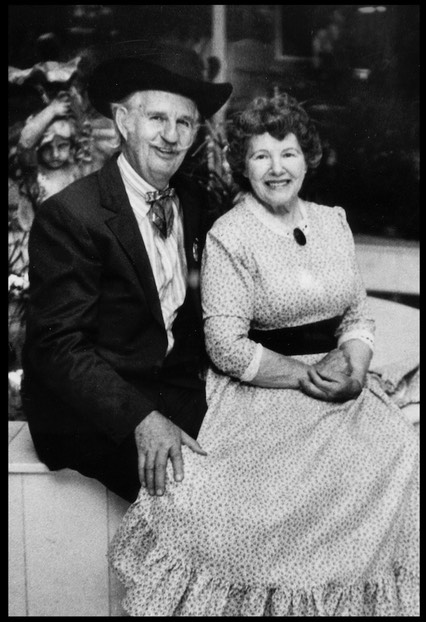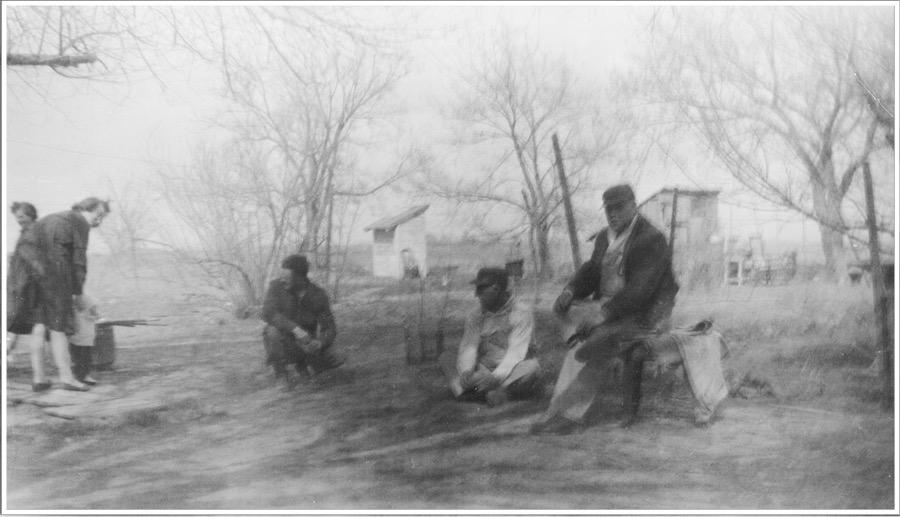A few days ago I finally got around to taking a close look at a photographic slide which I first noticed several years ago lying on the workbench in my garage. I’m still not sure how it got there, but I almost waited too long to do anything with it. Dyes had faded at uneven rates, leaving the slide with an overall ruby-red cast. There were also some stains and specks of dirt. Most of these flaws can be repaired with digital imaging software, though much of the original color information is long gone.

It turned out to be a picture of my grandmother Lillian Logan in her front parlor in 1962, posing with her youngest daughter’s first child, Jimmy Dieckman, on his very first visit to Grandma’s house. She looks younger than I remember her, even though she’s 75 here, with limbs swollen by congestive heart failure. In her face there’s still a flicker remaining of the younger woman who raised seven children, washed the family’s laundry in a galvanized tub, hung it out to dry on a clothesline, and in later years patiently picked up all the toys left strewn across her linoleum floor by visiting grandchildren who suddenly remembered they were late for supper.
It’s especially fitting to add the photo to this site, because Jim Dieckman has contributed to the array of pictures available for viewing here, including samples of his mother’s antique collectibles. I’ve put a few of my own baby pictures here, so I’m also playing fair.
Jim’s father was Carl Dieckman, who always brought an acoustic guitar to family gatherings and sometimes played a song or two while we digested a potluck meal. My memory is hazy on this one, but I believe there’s a story about Carl auditioning for Tex Ritter in the early 1960’s.
On a hunch I googled Carl’s name recently and was rewarded with an acoustic reminder. The Country Music Hall of Fame website contains recordings of Carl strumming his guitar and singing a few Jimmie Rodgers songs in the early 1950’s. I had searched the same website a few years ago when I was producing a TV documentary about Melody Matinee, a show that ran on KOAM-TV in Pittsburg, Kansas, from 1954 to 1985. When the program finally left the airwaves it was lauded as the longest-running daily entertainment show on television.

A frequent guest on Melody Matinee was Lloyd “Slim” Andrews, who had been Tex Ritter’s sidekick in a dozen or more movies in the 1940’s. Slim could play the fiddle, honky-tonk piano, accordion, and banjo serviceably well, and could coax some semblance of a tune from springs, lengths of garden hose, saws, and various kitchen appliances.
In Los Angeles he had been the host of a children’s show called The Old 49’er, relocating to an independent station in Fresno when the network affiliate in L.A. overhauled its lineup, before retreating to his old neighborhood in the Ozarks when even Fresno decided it was getting to be too cosmopolitan for Slim’s Depression-era schtick.
On his way back to Gravette, Arkansas, he pulled into the driveway at KOAM, a station which serves the inner corners of Kansas, Oklahoma, Arkansas and Missouri, where he would find a new platform for his skills for the next twenty-one years.
Since I had directed Melody Matinee on-and-off for more than a decade, I vividly remembered a number of the regular performers and had even snapped publicity photos for some of them. By the time we got around to producing a tribute to the long-canceled show, I was probably the only person remaining on the payroll who had a personal connection to it. Timing is everything.
This is all by way of introducing a photograph with only a tenuous connection to anything else I’ve written about on the blog today. It’s one of the worst family photographs I’ve come across in quite a while, evidently taken by an amateur with a box camera, probably using it for the first time in ages.

And yet I also find it compelling, perhaps because it’s so candid and completely artless. And because I instantly knew who everyone in the picture was, as well as where and when it was taken. Beyond who, where and when, I was pretty sure I understood why.
The year is 1961. It’s Thanksgiving at Grandma Logan’s house in Formoso, shortly after everyone has been thoroughly overfed. On the right is my uncle, Charlie Logan. Squatting on the ground next to him is another Logan uncle, Charlie’s older brother Bill. The younger man crouching to the left of Bill Logan is Jack Higbee. The three men were all local farmers.
Bill’s daughter-in-law Marie is playing with Jack’s little boy Michael. Jack’s mother-in-law, who is also Michael’s grandmother and my aunt, Vera Reed, is barely visible at the left side of the frame. I’m going to guess that another of my aunts, Irene Park, widowed two years earlier, is behind the camera, making it wobble a bit as she forcefully snaps the shutter. I not only know the people, but perhaps the unspoken emotion of the moment, the feeling of life’s impermanence that made Irene want to bring along the old camera in the first place to make a rare photographic record of the holiday gathering.
Michael, the youngest person in the photograph, died a few years ago at the age of 60. At his funeral, memorials were requested to assist families affected by Covid-19. Besides masks or other facial coverings, attendees were asked to wear “jeans, coveralls, bibs with a ball cap” or whatever made them comfortable.
You know, I’ve changed my mind. It’s not perfect, but it may be one of the best family pictures I own.